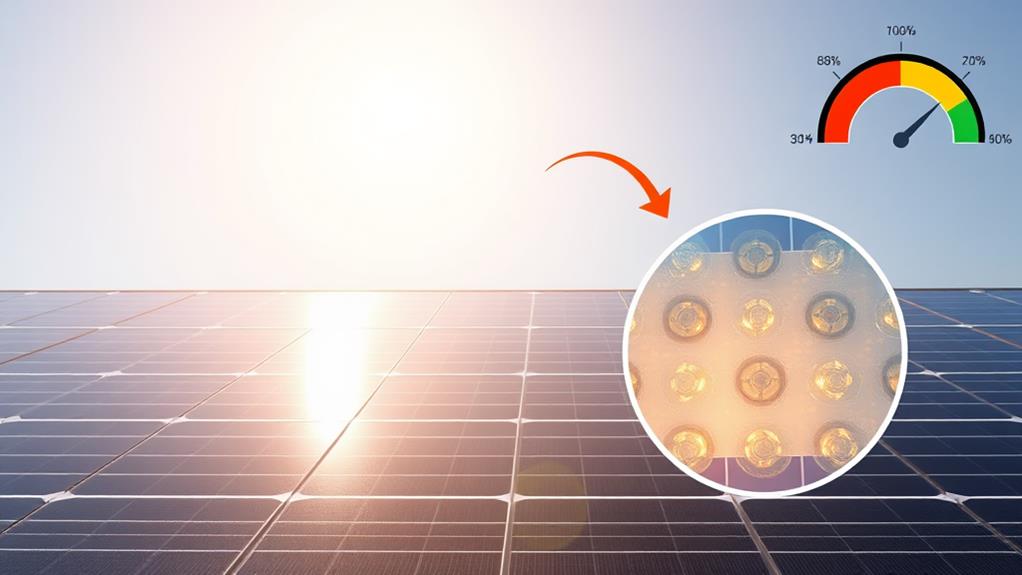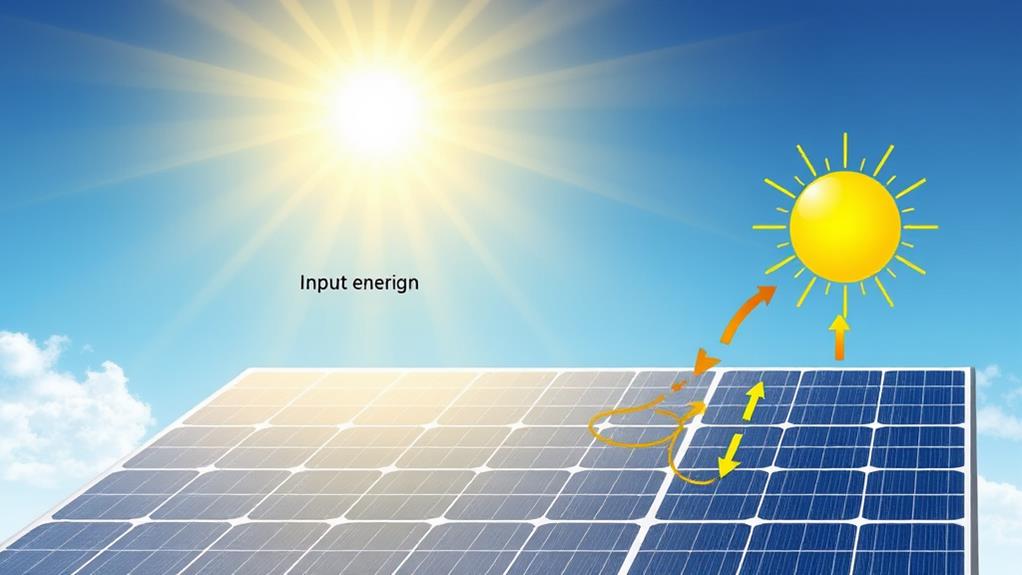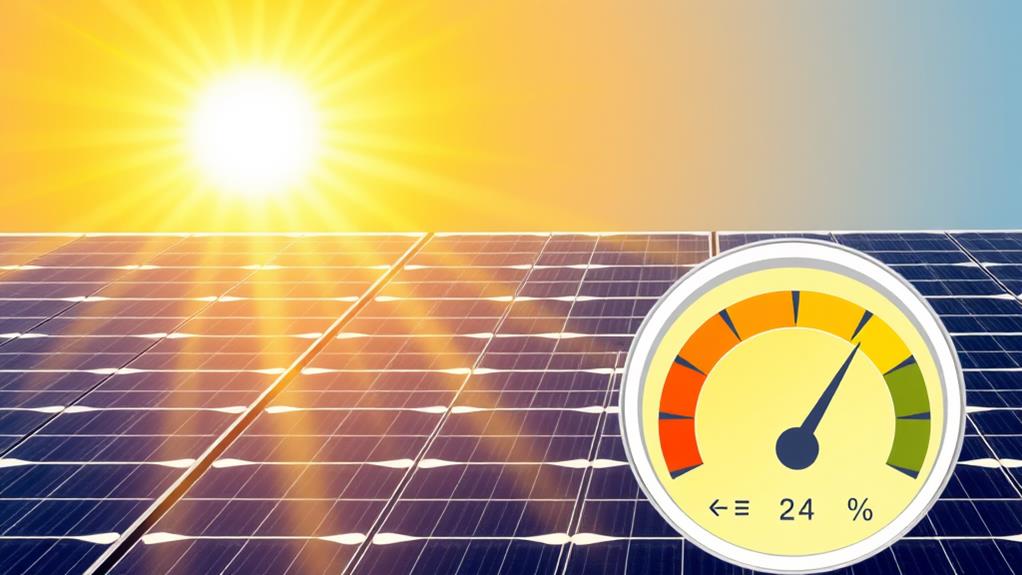Just as Archimedes found brilliance in simple principles, you can uncover the efficiency of a solar panel with some straightforward calculations. Start by measuring the electrical output using a wattmeter under standard conditions. Next, calculate the total solar energy input by considering the solar irradiance, panel surface area, and sunlight duration. With these figures in hand, you can apply an efficiency formula to see how well your panel converts sunlight into usable energy. Want to guarantee your solar panels perform at their peak? Let's explore how you can fine-tune this process.
Understanding Solar Panel Efficiency

When it comes to understanding solar panel efficiency, you need to grasp the concept of how effectively a solar panel converts sunlight into usable electricity.
This efficiency is the ratio of the electrical output of a solar panel to the incident energy in the form of sunlight. Fundamentally, it's a measure of the energy conversion capability of the solar technology you're considering.
To calculate this, you'll look at the amount of sunlight that hits the solar panel's surface and how much of that sunlight is converted into electrical energy. High-efficiency panels convert more sunlight into electricity, leading to greater energy output from the same amount of sunlight.
Additionally, modern panels are built with tempered glass and corrosion-resistant framing, ensuring durability and longevity.
Efficiency is influenced by several factors including the quality of the solar cells, the technology used, and the conditions under which the panel operates.
Advanced solar technologies, like monocrystalline cells, typically offer higher energy conversion rates compared to older technologies like polycrystalline cells.
Maximizing efficiency aligns with the desire for freedom from high energy costs and dependence on non-renewable energy sources.
Gathering Necessary Data
To accurately calculate solar panel efficiency, you must first gather necessary data. Start by identifying reliable data sources to guarantee precision. Key metrics include the amount of sunlight your panels receive, typically measured in kilowatt-hours per square meter (kWh/m²). You'll often find this information through meteorological databases or specialized solar irradiance websites.
Variations in solar irradiance can occur due to location, time of day, and weather conditions, which are vital factors to take into account.
Next, measure the panel's power output. Use a wattmeter to record the electrical power generated by your panel in kilowatts (kW). Confirm the readings are taken under standard testing conditions (STC) for consistency. You'll need to reference manufacturer datasheets for details on these conditions.
Collect data on the panel's surface area. Measure this in square meters (m²) using a tape measure or a laser distance meter for higher accuracy. Accurate measurement units are essential here to avoid errors in your efficiency calculations.
Validate all data is recorded in compatible measurement units. Convert units if necessary to maintain uniformity, as discrepancies can skew results.
Calculating Input Energy

Determining input energy is an essential step in calculating solar panel efficiency. To do this, you need to identify the input energy sources, primarily the solar irradiance that your panels receive. Solar irradiance is measured in watts per square meter (W/m²). You'll need to find the average solar irradiance for your location, which can be obtained from meteorological data or solar maps.
Solar panels are designed to convert sunlight into electricity, making understanding the irradiance levels critical.
Next, calculate the total input energy by multiplying the solar irradiance by the surface area of your solar panels. For example, if you have a panel with a surface area of 1.6 square meters and your location receives an average solar irradiance of 1,000 W/m², the input energy would be 1,600 watts.
Consider the duration of sunlight exposure, usually measured in hours per day. Multiply the total input energy by the number of sunlight hours to get the daily input energy.
Don't forget to factor in potential energy conversion losses due to atmospheric conditions or shading.
Measuring Output Energy
To measure the output energy of a solar panel, you'll need to record its power output under standard test conditions.
This involves using tools like a multimeter or a data logger to capture the voltage and current produced. Accurate efficiency testing methods guarantee you obtain reliable data essential for calculating overall efficiency.
Utilizing advanced technologies can further enhance the precision of your measurements, making it easier to assess the performance of your solar panel system.
Power Output Measurement
Measuring the output energy of a solar panel, a critical step in evaluating its efficiency, involves calculating the electrical power it generates under specific conditions.
To begin, verify your solar panel is exposed to standardized testing conditions (STC), which include a sunlight intensity of 1000 W/m², a panel temperature of 25°C, and an air mass of 1.5. These conditions help you obtain accurate power ratings.
Next, you'll need a multimeter to measure the current (I) in amperes and the voltage (V) in volts that the solar panel produces. Power (P), which is the product of current and voltage, is calculated using the formula P = I × V. This power measurement, typically in watts, reflects the panel's energy conversion capability under those specific conditions.
For a more thorough analysis, record these measurements over a period to account for varying environmental factors. This gives you a clearer picture of the panel's performance in real-world settings.
Efficiency Testing Methods
Having measured the power output of your solar panel, the next step involves examining various efficiency testing methods to gauge how effectively the panel converts sunlight into usable electricity.
You must consider both controlled lab testing and real-world performance to get a thorough understanding. Here are four vital steps:
- Lab Testing: Conduct tests in a controlled environment to eliminate variables. Assess factors like material quality, temperature impact, and panel orientation. This will provide you with baseline efficiency data.
- Real World Performance: Test the panel under typical operating conditions. Evaluate how environmental factors such as temperature impact, shading effects, and panel orientation influence performance. This helps you understand practical efficiency.
- Environmental Factors: Regularly monitor and document how changes in weather, ambient temperature, and shading effects impact your panel's efficiency. This data is significant for adjusting your system to enhance output.
- Installation Techniques: Analyze how different installation techniques affect performance. Improper installation can lead to significant efficiency losses, so verify your panel's orientation and tilt are ideal.
Determining Efficiency Percentage

Understanding how to determine the efficiency percentage of a solar panel is essential for evaluating its performance. To calculate this, you first need to take into account efficiency factors such as panel materials, temperature, and irradiance levels.
Begin by measuring the electrical output of the solar panel in watts. Next, calculate the total solar energy received by the panel, which is determined by the panel's surface area and the solar irradiance (usually given in watts per square meter).
The formula to ascertain efficiency percentage is:
\[ ext{Efficiency (\%)} = \left( rac{ext{Electrical Output (W)}}{ext{Solar Energy Input (W/m}^2ext{) } imes ext{ Panel Area (m}^2ext{)}} \right) imes 100 \]
For instance, if a panel outputs 300 watts and receives 1000 watts per square meter over a 1.5 square meter area, the calculation would be:
\[ ext{Efficiency (\%)} = \left( rac{300}{1000 imes 1.5} \right) imes 100 = 20\% \]
Tips for Improved Efficiency
Once you've determined the efficiency percentage of your solar panel, you might wonder how to enhance it further.
Maximizing solar panel efficiency guarantees you're converting the maximum amount of sunlight into usable energy, giving you greater independence and control over your energy needs.
Here are some precise tips to help improve your system's performance:
1. Regular Solar Panel Maintenance: Clean your panels quarterly to remove dirt, dust, and debris. Contaminants can block sunlight and reduce energy conversion effectiveness. Use a soft cloth and mild detergent to avoid scratching the surface.
Additionally, consider professional maintenance services from an MCS accredited company for thorough inspections and upkeep.
2. Ideal Tilt and Orientation: Adjust your panels to the ideal tilt angle and orientation for your geographic location. This guarantees maximum sun exposure throughout the year, enhancing energy conversion rates.
Professional installation services can help you determine the best positioning.
3. Minimize Shading: Guarantee there are no obstructions like trees or buildings casting shadows on your panels. Even partial shading can greatly reduce the overall effectiveness of your solar array.
4. Monitor and Upgrade Inverters: Regularly check your inverters for any issues. Inverters play a vital role in energy conversion.
Consider upgrading to a more efficient model if yours is outdated.
Conclusion
Imagine standing in the glow of a bright, sunlit day, knowing your solar panels are harnessing that radiant energy. By calculating the efficiency—measuring the output, determining the input, and applying the formula—you've revealed the secret to your panels' performance. With precision and care, you can optimize this sustainable power source. Each percentage point signifies a step towards greener, cleaner energy. Your diligence guarantees you're capturing the sun's potential at its fullest.
